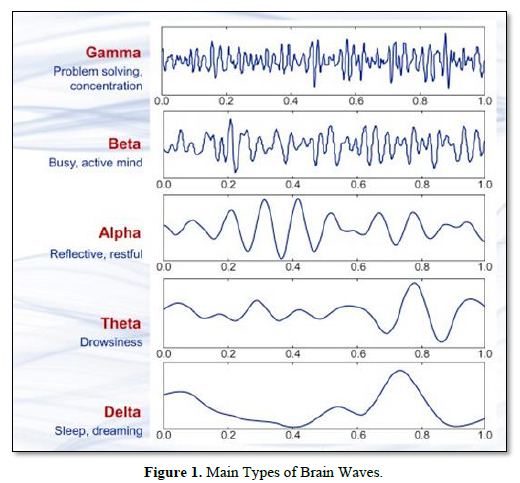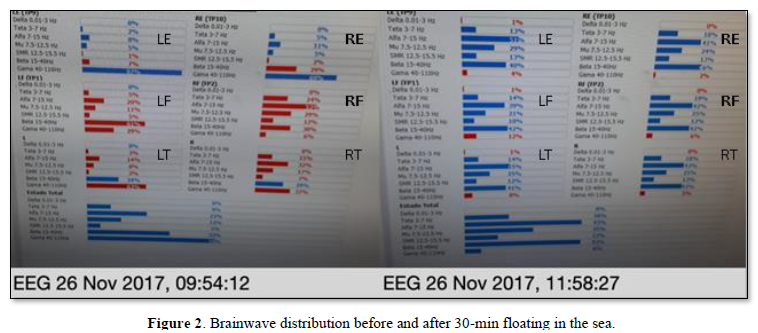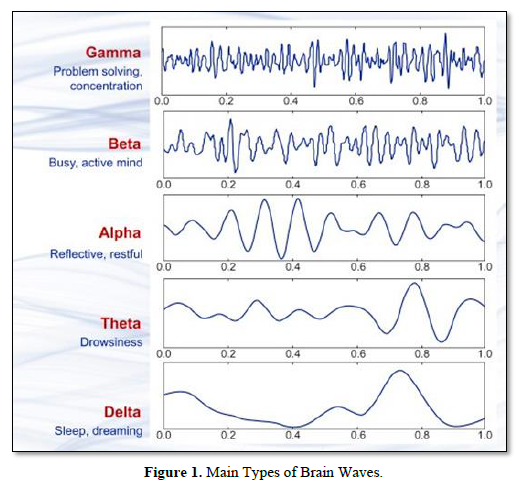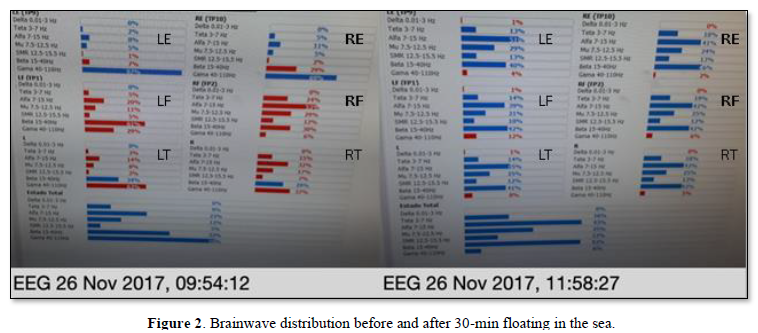442
Views & Citations10
Likes & Shares
ACCUSATION AND PRACTICAL EXPERIENCE
I was accused again to violate the 112th article of the Brazilian Code of Medical Ethics: Art.112: It is forbidden for the doctor to disclose information on medical matters in a sensationalist, promotional or untrue way. It was basically because I made a post in my personal Facebook account about excess of gamma waves in the brain and it was probably considered untrue, because it has nothing to do with sensationalism, promotion or something of the kind. I said that, when the brain is overloaded with gamma waves, we tend to feel unbalanced, anxious, tired. This time I will start writing about some practical experiences before searching for some scientific evidence on the issue. In 2017 I happened to meet a Dutch neuroscientist who developed a technology that uses an EEG-powered headband to scan the brain. Some specific data is also obtained through a microphone (Voice Analysis), but it was not considered a medical device by ANVISA - the National Health Surveillance Agency in my country - and not supposed to be used for diagnosis or treatment. I learned a lot from him about brainwaves which represent patterns of the electrical activity produced by the brain [1]. In other words: when a group of neurons sends a burst of electrical pulses to another group of neurons, it creates a wave-like pattern that can be registered [1]. Have a look on brain wave samples with dominant frequencies belonging to beta, alpha, theta, and delta bands and gamma waves and gamma waves (Figure 1) [2].
Delta waves are very slow (0,5 - 4 Hz) [1]. They are mostly associated with slow-wave dreamless sleep [1], often known as deep sleep or delta sleep [3]. They usually begin to appear in stage 3 of the sleep-cycle, and by stage 4 dominate almost all EEG activity [4]. At this stage, healing and regeneration are stimulated [4]. In fact, they are considered essential for the restorative properties of sleep [4]. An excess of delta waves when a person is awake may result in learning disabilities and Attention Deficit Hyperactivity Disorder (ADHD), making it extremely difficult to focus [4]. Theta waves (3 - 8 Hz) [1] are mainly related to drowsiness [2], light sleep and REM sleep [5]. REM sleep is when you dream and your eyes move rapidly, which is sometimes called active sleep [5]. Theta waves tend also to be more dominant when you’re deeply relaxed or in a deep meditative state [1]. Alpha waves (8 - 12 Hz) [1] represent a low arousal, restful state of mind [6]. They are associated with a feeling of wakeful relaxation [4], that is, when you feel a sense of calm and clarity: you’re awake, but feeling quiet and contemplative [5].
Beta waves (12 to 35 Hz) [1] are connected to a busy, active, alert, concentrated and focused mind [5]. You might be working on a project, engaged in a difficult task, or simply thinking about something that requires a lot of mental effort [5]. Beta waves also activate the sympathetic nervous system, which is responsible for the “fight or flight” response [5]. While this can be beneficial in short bursts, it’s not ideal for sustained periods of time [5]. Too much beta activity is linked to anxiety, insomnia, and depression [5]. Finally, gamma waves (35 - 100 Hz) [1] are considered to be the fastest brain activity [7]. They are linked to enhanced learning, problem solving, increased focus and concentration, improved memory, mental clarity and cognitive function [5,7]. Nonetheless, in excess, they are related to a lot of problems. Peak concentration and focus occur when gamma and beta waves are in sync [5].
All brainwaves are important. These waves can and do change, based on what we’re doing and how we’re feeling [1]. I used to have a terrible excess of gamma waves and my researcher friend would say that they certainly consumed a hell of a lot of energy, making the connection to constant fatigue, anxiety, headaches, insomnia and related symptoms [8]. In fact, gamma waves are increasingly being evaluated as a measure of brain glucose metabolism once gamma activation denotes active sites of cognition and, consequently, sugar metabolism by brain cells [8]. Then my friend gave me one of his EEG-headband sensors and installed his program in my computer so that I could be able to register the wave distribution of my own brain more often. I started to test it in a number of different situations: "before and after" meals, alcoholic drinks, bathing in the sea, resting on the grass, doing physical exercises, sleeping, listening to binaural beats, meditating, and so on. The most amazing results were after floating in the sea for 30 min. The pictures in Figure 2 are not great. However, you can have an idea of the changes in the brainwave distribution both in the left brain (the so-called “rational" brain) and in the right brain (the “emotional" brain instead). Observe that there was a lot of gamma wave activity in the first scan (09:54:12), particularly in the left ear (LE) and right ear (RE) areas in comparison to the left frontal (LF) and right frontal (RF) areas. The LE activity reduced from 97% to 4% after the intervention (30 min floating in the sea). The RE from 69% to 2%. The total left gamma wave activity (LT) reduced from 63% to 8%. The total right gamma wave activity (RT) from 37% to 5%. The final total brainwave distribution at 11:58:27 shows a more "balanced brain", with more alpha and beta waves and less gamma waves as compared to the first scan. The blue and red colors are related to the symmetry (blue) or asymmetry (red) between the left and right brain in each scan (Figure 2).

After a while, I started registering my patients’ brainwaves before and after the appointment with me. I must say that most of my patients are not really ill, I mean, they don’t usually have any kind of serious diseases. Most of them are looking for some nutritional advice to enhance their health. They tend to be open to any sort of information that could help them in their journey. Therefore, finding out their brain activity and what to do to get it more balanced was really considered some interesting additional information. The most positive thing about it was not only to see the changes in the brainwave patterns on the computer screen, but, actually, the fact that the patients did feel better after some sort of intervention, such as a 11-min mindfulness meditation or exercises for heart-brain coherence. My appointment started to last longer - from one hour to one and a half hours - so that I could offer a more holistic approach, giving a little more emphasis on lifestyle and stress management. Notwithstanding, for the sake of doing something out of the ordinary nutritional evaluation, I asked the patients to sign an informed consent form although I was not exactly doing something new in neuroscience. It was basically a simple electroencephalogram to check brainwave distribution. In short, around 2017 I started to make this connection of our state of being to brainwave distribution and to understand what Nikola Tesla - the well-known Serbian American inventor, engineer and physicist - meant with the words: "If you want to find the secrets of the universe, think in terms of energy, frequency and vibration” [9].
RESEARCH AND COMMON SENSE
Let’s try to show some scientific evidence on the relationship between excess of gamma waves, thoughts, emotions and tiredness. A type of tiredness that is not treated only with supplements, such as adaptogens, magnesium, coenzyme Q-10, vitamin B12 and others.
- It’s only when activity of each type of brainwaves falls outside the range of normalcy that adverse effects are noted [5], especially if for prolonged periods of time.
- Gamma in the human brain has many well-defined roles in modern neuroscience. Gamma is usually a wave of active cognition, a "thinking" wave [8]. Sometimes too much gamma activity is a hallmark and useful measure of anxiety, attention-deficits, trauma and, in extreme cases, epilepsy, among many other roles [8]. A 2011 study concluded that gamma oscillations are especially energy demanding and require both high nicotinamide adenine dinucleotide: ubiquinone oxidoreductase (complex I) expression and strong functional performance of the mitochondria [10], the organelle of energy production in our cells.
- Meditation is a mental training, capable of producing connection between the mind, body and spirit [11]. Its practice helps people to achieve balance, relaxation and self-control in addition to the development of consciousness [11]. At present meditation is classified as a complementary and integrative technique in the area of health [11]. Typically, a meditator needs to initiate and maintain a relaxed, calm state before entering into a deeper meditative state [6]. This change in state often necessitates switching from beta to alpha activity and, subsequently, to theta activity [6].
- Thoughts are connected to emotions. Your emotions result from the way you think about things. Before you can experience (feel) any event, you must process it with your mind and give it a meaning (thought) [12]. Therefore, if you think you are a failure, you have a feeling of worthlessness. If you think it was heartbreaking to split up with your partner, you have a feeling of sadness. If you think you might not have money enough to pay your bills, you have a feeling of concern, and so on. Unless, from a spiritual point of view, you learn not to identify yourself with your thoughts, when the mind slowly becomes an object [13]. However, most people are not able to see the internal world as an object and tend to flow with the mind, being at times happy and at times miserable, at times at peace and at times in utter despair [13].
- Obviously, the brain can’t have predominantly high frequency and low frequency waves at the same time. Either one type or the other, although it can have predominantly high frequency waves with some slow frequency waves and vice-versa.
- In conclusion, a lot of thoughts and emotions are linked to an excess of gamma waves, and, in consequence, high energy consumption by the brain. In the long run it may be the cause of a type of tiredness that “comes from the brain”. Supplements, in general, cannot slow down the brainwaves as efficiently as some practices which make us reach a more reflective, restful state of mind. That was basically what I said in the post which was apparently considered non-scientifically proven knowledge. Don’t forget that it was in my personal Facebook account where I was supposed to be talking to “friends”.
A RISING TIDE RAISES ALL BOATS
You might have heard of the Age of Aquarius. In astrology it is either the current or the forthcoming astrological age, depending on the method of calculation, coming after the Age of Pisces at the moment when the sun on the day of the autumn or spring equinox rises in front of the Constellation of Aquarius [14]. Well, I have to admit that I don’t really know much about it. A quick and superficial search on Google tell us: "The Age of Aquarius is the period in which collectivity, cooperation, sustainability, opposition to authoritarianism, communication and the perception of the world no longer as that of individuality will dictate the rules” [15]. All related to peace, love, understanding and living in harmony [16]. In the same post mentioned before I made some reference to the Age of Aquarius because the name of my researcher friend’s program is connected to it. For some reason it was also judged inappropriate. Anyway, I will just leave it all behind. Let’s get some wisdom from Bernard Shaw (1856 - 1950) - the Irish playwright, novelist, short story writer and journalist - when he said: “Imagination is the beginning of creation. You imagine what you desire, you will what you imagine, and at last, you create what you will.” So, may something really humanistic, cooperative, positive, creative and inspiring come out of the problems we are facing today in the medical world. With love and glory.
- Healthline (2023) What to Know About Gamma Brain Waves. Available online at: https://www.healthline.com/health/gamma-brain-waves
- Abhang PA, Gawali BW, Mehrotra SC (2016) Introduction to EEG- and Speech-Based Emotion Recognition. Cambridge, Massachusetts, Academic Press.
- Sleep Foundation (2023) Stages of sleep. Available online at: https://www.sleepfoundation.org/stages-of-sleep#:~:text=The%20brain%20activity%20during%20thisfor%20bodily%20recovery%20and%20growth
- Neurofeedback Alliance (2023) Understanding brainwaves. Available online at: https://neurofeedbackalliance.org/understanding-brain-waves
- Try Healium (2023) Deep Dive into Gamma Brainwaves | Benefits of Gamma Waves & How to Balance Them. Available online at: https://www.tryhealium.com/2022/09/01/gamma-brainwaves
- Tang YY, Tang R, Rothbart MK, Posner MI (2019) Frontal theta activity and white matter plasticity following mindfulness meditation. Curr Opin Psychol 28: 294-297.
- Science Direct (2023) Gamma waves. Available online at: https://www.sciencedirect.com/topics/neuroscience/gamma-wave
- Brain waves (2023) The modern meditators introduction. Accessed on: April 26, 2023. Available online at: https://jordan-kiefer-osullivan.medium.com/brainwaves-the-modern-meditators-introduction-681ae53fde0b
- Famous quotes and phrases (2023) Available online at: https://citacoes.in/citacoes/999326-nikola- tesla-if-you-want-to-find-the-secrets-of-the-universe-t
- Kann O, Huchzermeyer C, Kovács R, Wirtz S, Schuelke M (2011) Gamma oscillations in the hippocampus require high complex I gene expression and strong functional performance of mitochondria. Brain 134(2): 345-358.
- Sampaio CV, Lima MG, Ladeia AM (2017) Meditation, Health and Scientific Investigations: Review of the Literature. J Relig Health 56(2): 411-427.
- Villagra M (2023) The link between thoughts and emotions: How to change your feelings by changing your thinking. Available online at: https://www.kevinmd.com/2023/01/the-link-between-thoughts-and-emotions-how-to-change-your-feelings-by-changing-your- thinking.html
- Prajnanananda P (2002) The changing nature of relationships. Vienna, Austria, Prajna Publication.
- The Age of Aquarius (2023) Wikipedia the Free Encyclopedia. Available online at: https://en.wikipedia.org/wiki/Age_of_Aquarius
- Planetario de Vitoria (2023) Available online at: https://planetariodevitoria.org/en/stars/what-is-the-planet-of-aquarius-sign.html
- Laskowski-Jones L (2015) Embracing the Age of Aquarius. Nursing 45(9): 6.
QUICK LINKS
- SUBMIT MANUSCRIPT
- RECOMMEND THE JOURNAL
-
SUBSCRIBE FOR ALERTS
RELATED JOURNALS
- Journal of Neurosurgery Imaging and Techniques (ISSN:2473-1943)
- International Journal of Diabetes (ISSN: 2644-3031)
- Advance Research on Alzheimers and Parkinsons Disease
- Journal of Nursing and Occupational Health (ISSN: 2640-0845)
- Journal of Psychiatry and Psychology Research (ISSN:2640-6136)
- Journal of Rheumatology Research (ISSN:2641-6999)
- Archive of Obstetrics Gynecology and Reproductive Medicine (ISSN:2640-2297)



